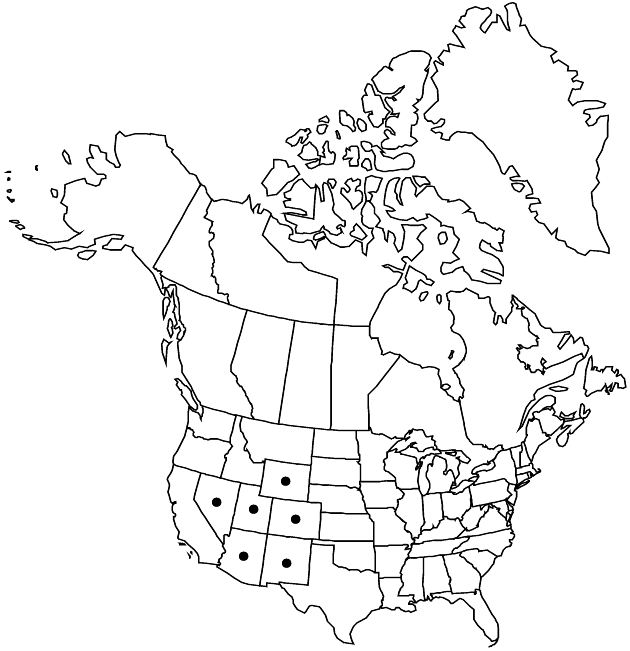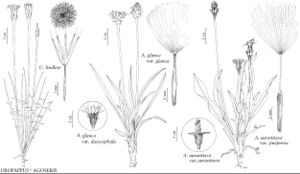Difference between revisions of "Agoseris aurantiaca var. purpurea"
Rhodora 50: 33. 1948.
FNA>Volume Importer |
FNA>Volume Importer |
||
| Line 8: | Line 8: | ||
}} | }} | ||
|common_names=Colorado Plateau agoseris | |common_names=Colorado Plateau agoseris | ||
| − | |basionyms={{Treatment/ID/ | + | |basionyms={{Treatment/ID/Basionym |
|name=Macrorhynchus purpureus | |name=Macrorhynchus purpureus | ||
|authority=A. Gray | |authority=A. Gray | ||
| + | |publication_title=Mem. Amer. Acad. Arts, n. s. | ||
| + | |publication_place=4: 114. 1849 | ||
}} | }} | ||
|synonyms={{Treatment/ID/Synonym | |synonyms={{Treatment/ID/Synonym | ||
| Line 63: | Line 65: | ||
|elevation=1800–3600 m | |elevation=1800–3600 m | ||
|distribution=Ariz.;Colo.;Nev.;N.Mex.;Utah;Wyo. | |distribution=Ariz.;Colo.;Nev.;N.Mex.;Utah;Wyo. | ||
| − | |discussion=<p>Variety purpurea is known mainly from the Colorado Plateau and southern Rocky Mountains. The two varieties are partially sympatric in the mountains of Colorado, Utah, southern Wyoming, and northern New Mexico, <i></i>var.<i> aurantiaca</i> occurring only at very high elevations in that region. Wherever <i></i>var.<i> purpurea</i> and <i></i>var.<i> aurantiaca</i> occur together, they intergrade. Hybrids between <i></i>var.<i> purpurea</i> and <i>A. glauca</i> or <i>A. parviflora</i> occur. One hybrid has been named (as a species): <i>Agoseris aurantiaca </i>var.<i> purpurea</i> × <i>A. glauca </i>var.<i> dasycephala</i> (= A. ×montana Osterhout) occurs sporadically at high elevations in the Rocky Mountains of Colorado.</p><!-- | + | |discussion=<p>Variety purpurea is known mainly from the Colorado Plateau and southern Rocky Mountains. The two varieties are partially sympatric in the mountains of Colorado, Utah, southern Wyoming, and northern New Mexico, <i></i></i>var.<i><i> aurantiaca</i> occurring only at very high elevations in that region. Wherever <i></i></i>var.<i><i> purpurea</i> and <i></i></i>var.<i><i> aurantiaca</i> occur together, they intergrade. Hybrids between <i></i></i>var.<i><i> purpurea</i> and <i>A. glauca</i> or <i>A. parviflora</i> occur. One hybrid has been named (as a species): <i>Agoseris aurantiaca </i>var.<i> purpurea</i> × <i>A. glauca </i>var.<i> dasycephala</i> (= A. ×montana Osterhout) occurs sporadically at high elevations in the Rocky Mountains of Colorado.</p><!-- |
| − | --><p>Variety purpurea tends to exhibit a higher frequency of yellow-flowered populations than <i></i>var.<i> aurantiaca</i>. Plants of <i></i>var.<i> purpurea</i> from the Rocky Mountains usually have orange corollas; those from the plateaus of southern Utah and northern Arizona often have yellow corollas. These more southwestern populations have been called <i>A. arizonica</i> (or <i>A. purpurea</i> <i></i>var.<i> arizonica</i>); the two regional phases cannot be adequately separated and their segregation is arbitrary.</p> | + | --><p>Variety purpurea tends to exhibit a higher frequency of yellow-flowered populations than <i></i></i>var.<i><i> aurantiaca</i>. Plants of <i></i></i>var.<i><i> purpurea</i> from the Rocky Mountains usually have orange corollas; those from the plateaus of southern Utah and northern Arizona often have yellow corollas. These more southwestern populations have been called <i>A. arizonica</i> (or <i>A. purpurea</i> <i></i></i>var.<i><i> arizonica</i>); the two regional phases cannot be adequately separated and their segregation is arbitrary.</p> |
|tables= | |tables= | ||
|references= | |references= | ||
| Line 88: | Line 90: | ||
|publication year=1948 | |publication year=1948 | ||
|special status= | |special status= | ||
| − | |source xml=https://jpend@bitbucket.org/aafc-mbb/fna-data-curation.git/src/ | + | |source xml=https://jpend@bitbucket.org/aafc-mbb/fna-data-curation.git/src/f6b125a955440c0872999024f038d74684f65921/coarse_grained_fna_xml/V19-20-21/V19_499.xml |
|tribe=Asteraceae tribe Cichorieae | |tribe=Asteraceae tribe Cichorieae | ||
|genus=Agoseris | |genus=Agoseris | ||
Revision as of 18:37, 24 September 2019
Leaf blades: margins usually dentate to laciniately pinnatifid, rarely entire, faces mostly glabrous and often glaucous. Peduncles mostly longer than leaves at flowering, glabrate or apically ± villous to lanate. Phyllaries ± stramineous proximally, green, often purple-black blotched or spotted, or with a purple-black midstripes, rarely nearly all black, usually ovate or obovate, sometimes lanceolate, subequal to unequal at flowering, margins ± ciliate, especially distally, faces glabrous or slightly pubescent basally or medially; outer mostly glabrous adaxially. Corollas usually orange or yellow, sometimes pinkish, subequal to or surpassing inner phyllaries. Cypselae: bodies ± gradually tapered to beaks, ribs ± weakly and uniformly ridged (not thickened distally). 2n = 18, 34, 36.
Phenology: Flowering Jun–Sep.
Habitat: Moist, subalpine meadows and forests to alpine tundra, often disturbed areas
Elevation: 1800–3600 m
Distribution

Ariz., Colo., Nev., N.Mex., Utah, Wyo.
Discussion
Variety purpurea is known mainly from the Colorado Plateau and southern Rocky Mountains. The two varieties are partially sympatric in the mountains of Colorado, Utah, southern Wyoming, and northern New Mexico, var. aurantiaca occurring only at very high elevations in that region. Wherever var. purpurea and var. aurantiaca occur together, they intergrade. Hybrids between var. purpurea and A. glauca or A. parviflora occur. One hybrid has been named (as a species): Agoseris aurantiaca var. purpurea × A. glauca var. dasycephala (= A. ×montana Osterhout) occurs sporadically at high elevations in the Rocky Mountains of Colorado.
Variety purpurea tends to exhibit a higher frequency of yellow-flowered populations than var. aurantiaca. Plants of var. purpurea from the Rocky Mountains usually have orange corollas; those from the plateaus of southern Utah and northern Arizona often have yellow corollas. These more southwestern populations have been called A. arizonica (or A. purpurea var. arizonica); the two regional phases cannot be adequately separated and their segregation is arbitrary.
Selected References
None.
